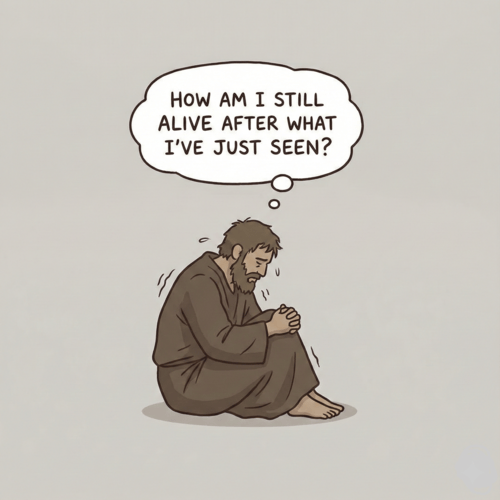How ‘Embarrassing Details’ Strengthen the Case for Gospel Authenticity
When examining ancient texts for historical reliability, scholars often apply what’s known as the “criterion of embarrassment.” The principle suggests details that may embarrass or create difficulties for the authors are less likely to be fabricated. After all, why would someone inventing a story include elements that undermine their goals?
The Gospels—Matthew, Mark, Luke, and John—contain numerous details that would have been problematic or embarrassing for the early church. These “difficult” elements actually provide compelling evidence for the authenticity of these accounts. Rather than presenting idealised narratives, the Gospel writers included uncomfortable truths that suggest they were committed to accuracy even when the facts weren’t convenient.
DISCIPLES PORTRAYED IN A NEGATIVE LIGHT
The portrayal of Jesus’ closest followers is remarkably unflattering throughout the Gospels. Far from being portrayed as heroes, the disciples frequently appear slow-witted, ambitious, fearful, and faithless:
- Peter, the future leader of the church, denies knowing Jesus three times after boldly claiming he would die with him. This same pattern of overconfidence followed by failure appears repeatedly in Peter’s story.
- The disciples consistently fail to understand Jesus’ teachings, prompting him to ask, “Are you still so dull?” (Matthew 15:16). Even after explicit explanations, they miss the point of his parables and mission.
- Again, the disciples argue about which of them is the greatest even as Jesus speaks of his coming death. Later, when Jesus faces arrest, they all flee in fear, abandoning him in his hour of greatest need.
- Thomas refuses to believe in the resurrection without physical proof, demanding to touch Jesus’ wounds—hardly the portrayal you’d expect if the story were fabricated.
- Judas, one of the Twelve, betrays Jesus for a modest sum. The early church would have little reason to invent the idea that one of Jesus’ handpicked followers turned against him.
These unflattering portrayals make little sense if the Gospels were merely propaganda. They make perfect sense if the writers were committed to recounting what actually happened, even when those events didn’t cast the church’s founding leaders in the best light.
JESUS IN MOMENTS OF VULNERABILITY
The Gospels also depict Jesus Himself in ways that may seem—to some—as problematic for early Christians proclaiming him as divine:
- In Gethsemane, Jesus appears deeply distressed, asking for “this cup” to be taken from him if possible—hardly the portrayal of an impassive, all-powerful deity.
- On the cross, Jesus cries out, “My God, my God, why have you forsaken me?” (Mark 15:34)—words that could easily be misinterpreted as despair or abandonment.
- Jesus openly acknowledges limitations to his knowledge, stating that not even the Son knows the day or hour of the end (Mark 13:32).
- The Gospels show Jesus experiencing hunger, thirst, fatigue, and other human limitations. At times, he appears frustrated with his disciples’ lack of understanding.
- Mark even records that Jesus’ family thought he was “out of his mind” (Mark 3:21), a detail that early Christians would have little motivation to invent.
These portrayals of Jesus’ humanity and vulnerability stand in tension with early Christian proclamations of His divinity. Their inclusion suggests the Gospel writers were working with reliable traditions they felt obligated to preserve, not crafting idealised portraits.
CULTURAL EMBARRASSMENTS
Many Gospel details would have been culturally embarrassing, even counterproductive for the early church:
- Women are presented as the first witnesses to the resurrection, despite the fact that female testimony was not considered reliable in ancient Jewish courts. If the resurrection accounts were fabricated, why not make Peter or John the first witness?
- Jesus associates freely with tax collectors, prostitutes, Samaritans, and other social outcasts—connections that would have raised eyebrows rather than boosting his credibility.
- Jesus submits to baptism by John the Baptist—a ritual for the repentance of sins—creating the awkward impression that Jesus might be subordinate to John or in need of repentance.
- The central event of the Gospels is Jesus’ crucifixion—an execution method so shameful that Roman citizens were exempt from it. Paul acknowledges this as a “stumbling block” to Jewish audiences (1 Corinthians 1:23).
- Jesus’ birth in humble circumstances and his upbringing in Nazareth (prompting the sceptical question “Can anything good come from Nazareth?”) would not have been invented by someone trying to create an impressive Messiah figure.
COUNTER-INTUITIVE OR PROBLEMATIC DETAILS
The Gospels include numerous details that seem counter-intuitive or potentially problematic for early Christian teaching:
Jesus sometimes speaks harshly, as when He addresses his mother as “Woman” at the wedding in Cana (John 2:4) or initially rebuffs the Syro-phoenician woman seeking healing for her daughter (Mark 7:27).
The Gospels preserve many “hard sayings” of Jesus that would have challenged rather than attracted followers, such as the requirement to “hate” one’s family (Luke 14:26) or the statement that many who seek to enter will not be able to (Luke 13:24).
Jesus frequently refuses to perform miracles on demand and sometimes instructs those He heals not to tell others—the opposite approach you’d expect if the stories were created to maximise His appeal.
The Gospels contain apparent discrepancies in details and chronology that a coordinated effort of fabrication would likely have eliminated.
Jesus sometimes appears to require secrecy about his identity (the “Messianic secret”), which seems counterproductive if the goal was to establish his credentials.
WHY THESE “FLAWS” STRENGTHEN THE CASE FOR GOSPEL AUTHENTICITY
These problematic details actually strengthen the case for the Gospels’ reliability in several ways:
- The principle of embarrassment: tells us people don’t typically invent stories that create difficulties for themselves. The inclusion of embarrassing details suggests the Gospel writers were constrained by what actually happened and by established traditions they couldn’t simply modify.
- The writers show remarkable restraint by not “fixing” problems that later non-canonical gospels often attempted to address. For instance, the second-century Gospel of Peter removes the cry of dereliction from the cross, while the Gospel of Thomas eliminates Jesus’ suffering entirely.
- The accounts cohere with their historical context while often running counter to cultural expectations—exactly what we would expect from truthful reporting of unusual events.
- Many details have the ring of eyewitness testimony—specific, vivid, and including irrelevant minutiae that fabricators typically wouldn’t invent, such as Jesus writing in the dust when confronted about the woman caught in adultery.
- Comparison with later writings shows how later authors tended to “clean up” these problematic elements, making Jesus more obviously divine and his disciples more heroic. The canonical Gospels’ willingness to include difficult material distinguishes them from later legendary developments.
The Gospel writers’ honesty about unflattering details suggests their trustworthiness regarding other claims. If they were willing to include material that created difficulties for them, we have reason to trust their testimony even in extraordinary claims such as the resurrection.
CONCLUSION: EMBARRASSING DETAILS STRENGTHEN GOSPEL AUTHENTICITY
The “embarrassing” elements in the Gospels create a cumulative case for their historical authenticity. Far from undermining the credibility of these accounts, the inclusion of difficult, counterproductive, and unflattering details suggests the Gospel writers were committed to preserving accurate traditions even when those traditions created challenges.
What emerges from these imperfect narratives is not a sanitised religious fiction but a faith grounded in historical realities—messy, complex, and sometimes uncomfortable. Paradoxically, it’s precisely the “flaws” in these accounts that give us the greatest confidence in their reliability. The Gospels present us not with idealisations but with history, preserved by writers more committed to truth than to convenience.
EMBARRASSING DETAILS STRENGTHEN GOSPEL AUTHENTICITY: RELATED FAQs
Why don’t other ancient religious texts contain similar “embarrassing details”? Most ancient religious texts were carefully crafted to present idealised narratives that supported theological claims without uncomfortable contradictions. Unlike the Gospels, texts such as the Quran, the Book of Mormon, or even Greco-Roman myths typically portray their central figures and followers in consistently positive or heroic terms. The Gospels stand out precisely because they preserve difficult details that don’t fit neatly into a triumphant narrative, suggesting the writers valued historical accuracy over theological convenience.
- How does the criterion of embarrassment relate to divine inspiration? Divine inspiration doesn’t eliminate human elements in Scripture but works through them while preserving historical truthfulness. God chose to inspire accounts that include the failings of disciples, the sufferings of Christ, and other challenging details rather than producing sanitised, idealised narratives. This approach to inspiration demonstrates God’s commitment to truth and His willingness to work through imperfect human instruments, revealing both His sovereignty and His respect for historical reality.
- If these details were truly embarrassing, why didn’t early copyists remove them? The early Christian community treated the apostolic writings with remarkable reverence, preserving rather than editing out difficult details. We have thousands of early manuscripts showing consistency in these embarrassing elements, suggesting believers viewed these texts as authoritative testimony to be preserved rather than improved upon. This faithful transmission—despite the temptation to “fix” problems—provides further evidence that the early church was committed to historical accuracy rather than self-serving revisions.
How do modern skeptics respond to the criterion of embarrassment? Some sceptics argue embarrassing details may have been included strategically to make fabricated accounts seem more believable. However, this explanation becomes less plausible when we consider the ancient context where honour and shame were paramount social concerns, making deliberate inclusion of shameful elements culturally counterintuitive. Additionally, the sheer volume and consistency of embarrassing details across multiple Gospel accounts suggest they stem from historical memory rather than calculated literary strategy.
- How does Jesus’ treatment of women compare to other religious founders of the time? Jesus’s respectful treatment of women and their prominent role in his ministry stands in stark contrast to contemporary religious norms. He taught women directly (Luke 10:39), engaged them in theological discussion (John 4), defended them against accusers (John 8:1-11), and first appeared to them after his resurrection—all practices that would have undermined rather than enhanced his credibility in the ancient world. This countercultural approach to women provides further evidence that the Gospel writers were recording actual events rather than constructing an appealing narrative for their context.
- Does the inclusion of miracles undermine the historical reliability suggested by embarrassing details? The presence of miracle accounts doesn’t negate the historical evidence provided by embarrassing details but should be evaluated within the complete historical context. The Gospels present miracles matter-of-factly alongside mundane details, suggesting the writers approached both with the same commitment to accurate reporting. Rather than viewing miracles as automatically disqualifying historical reliability, we should recognize that if the evidence points to generally trustworthy accounts, we should at least consider whether the miraculous elements might also be faithfully reported.
How do the “embarrassing details” in the Gospels compare to those in the Old Testament? Like the Gospels, the Old Testament frequently includes unflattering portrayals of its heroes, from Abraham’s deception to David’s adultery to Israel’s repeated failures. This consistent pattern across Scripture of recording human failings suggests an ongoing commitment to historical truthfulness rather than idealised religious propaganda. The portrayal of flawed individuals used by God runs counter to the typical ancient approach of glorifying religious and national heroes and provide evidence for the Bible’s unique commitment to truth-telling even when inconvenient.
EMBARRASSING DETAILS: OUR RELATED POSTS
Editor's Pick

The Throne-Room Vision: Who Did Isaiah See?
The scene is unforgettable: Isaiah stands in the temple, and suddenly the veil between heaven and earth tears open. He [...]

The Angel of the Lord: Can We Be Certain It Was Christ All Along?
Throughout the Old Testament, a mysterious figure appears: the Angel of the LORD. He speaks as God, bears God’s name, [...]
SUPPORT US:
Feel the Holy Spirit's gentle nudge to partner with us?
Donate Online:
Account Name: TRUTHS TO DIE FOR FOUNDATION
Account Number: 10243565459
Bank IFSC: IDFB0043391
Bank Name: IDFC FIRST BANK






